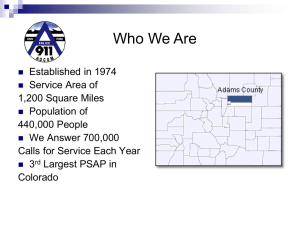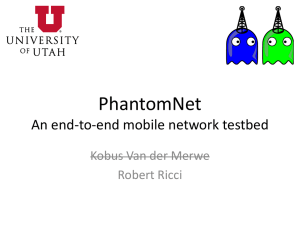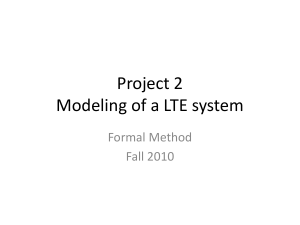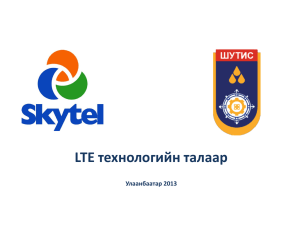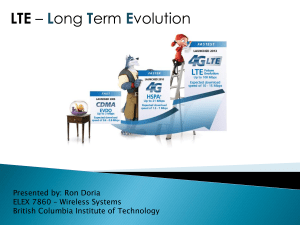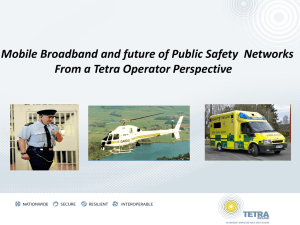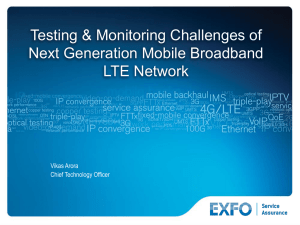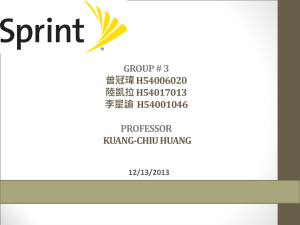- ISQT International
advertisement
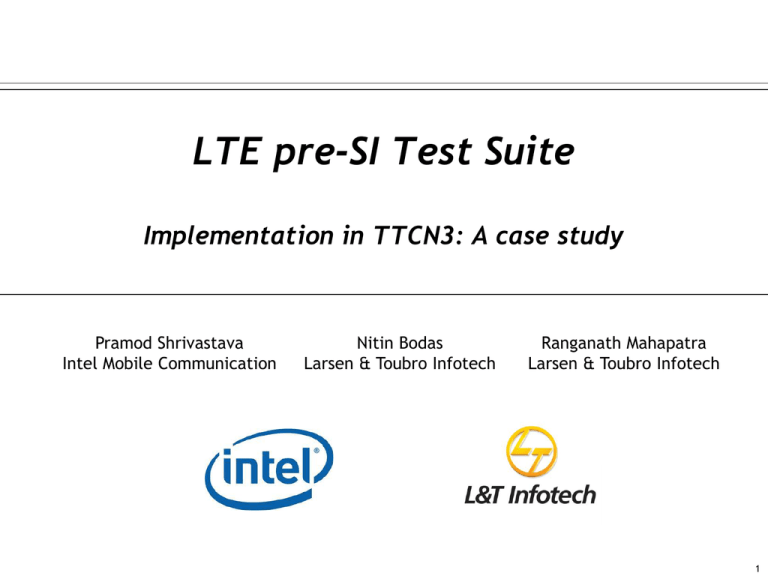
LTE pre-SI Test Suite Implementation in TTCN3: A case study Pramod Shrivastava Intel Mobile Communication Nitin Bodas Larsen & Toubro Infotech Ranganath Mahapatra Larsen & Toubro Infotech 1 Introduction LTE pre-System Integration (pre-SI) test suite for testing UE modem in a simulated environment. Specifically designed to address IOT, field testing, inter-RAT scenarios and testing of complex functional areas. Implemented on a multi-mode LTE protocol stack running on a host system and interacting with an automation framework through message queues. The main objective of this suite was to advance the testing phase, typically carried out at a later stage and thereby improve the overall testing process. The test cases were developed in TTCN3. 2 UE Modem Development & Validation Phases Protocol Layers Physical and RF Layer Advance Features OS Porting & Peripherals Pre-SI Conformance Testing Certification Support Field Testing Requirement Testing Performance & Stress Testing IOT SI Operator Acceptance Testing Post-SI Pre-SI phase: Protocol layers such as Physical Layer, L2 and L3 consisting of MAC, RRC, RLC, NAS & PDCP layers are developed independently SI Phase: Protocol layers (L2 &3) are integrated with physical layer, RF and other components or modules and ported to UE modem Post-SI Phase: the UE modem undergoes development and validation with focus on customer acceptance, certification testing etc. 3 Incremental Development & Testing Test Case Execution Test Case Development/Enhancement Protocol Stack Development/Enhancement Release 8 Release 9 Release 10 Phase-1 Phase-2 Phase-3 ……… Host Environment Development Phase-1 Phase-2 Phase-3 ……… 4 3GPP Releases & Features covered in the Test Suite LTE/EPC Rel. 8 LTE FDD & TDD Interfaces LTE FEDD & TDD Layer 1,2,3 delimitations Security support Mobility Features & IRAT EPC Definition and support EPC charging Advanced Antenna,: MIMO, FSS CS Fall Back SRVCC SON Features Home eNB IMS Support LTE/EPC Rel. 9 Positioning Support LTE in 800 MHz NW based Positioning IMS Emergency Public Warning System Home eNB eMBMS support in LTE Enhanced DL Transmission Vocoder rate adaptation SON Features LTE/EPC Rel. 10 Bandwidth aggregation Relays and Repeaters MIMO Enhancements Multisite Cooperative Transmission Incremental approach to develop the stack, network emulator and test suite. Synced up with 3GPP releases with respect to feature enhancements and addition of new features. Test Cases categorized into complex functional, IOT, security, inter-RAT, field testing and other functional areas. 5 Filtering of Test Cases SI Test Cases Complex Functional Test Cases Field Test Cases IOT Test Cases GCF Test Cases Influenced Test Cases Pre-SI Phase 1 Pre-SI Phase 2 Pre-SI Phase 3 Non-Influenced Test Cases 6 Test Environment Network Side Emulator 2G/3G/4G UE System Adaptation Layer / NAS Layer 3 Pre-SI Test Suite in TTCN-3 System Adaptation Layer System Adaptation Layer 2G/3G/ L2 Layer 4G LTE (PDCP/RLC/MAC) L1 MAC Adaptation Layer AT/MMI Commands Layer 2 MAC Adaptation Layer MSG Q or UDP/IP The test cases are executed using host based tri-mode automation framework. It supports validation of both LTE and legacy technologies. The framework and UE protocol stack interact with each other in message queues and also preserves LTE frame timing. 7 Sample Scenario#1 LTE [Packet Call] CS-FB call UMTS Add a bearer End CS-FB call back to LTE with both bearers. MT Voice Call Voice Call End Web Browsing CS-fall back FTP Download 8 Sample Scenario#2 UE circulates around cells of different RATs 9 Addressing Challenges Test scenario identification is one of the key challenges in the development of the pre-SI Test suite due to limitations and evolution of protocol stack or host environment. These challenges are addressed ensuring the following aspects: Extensive knowledge of standard and release enhancements in multi RAT context Extensive knowledge in SI and post-SI test areas Test coverage to replicate field or real life scenarios including negative and concurrent scenarios etc Test cases were converted in to message flows followed by scripting which requires excellent understanding of the interaction between UE modem and network. 10 Conclusion Pre-SI test suite was developed with test scenarios typically executed in SI and post-SI phases. The objective of this suite is to reduce multimode LTE UE development time. The test suite is designed such that it can also be used in SI and post-SI phase on commercial network simulator. The suite is continually enhanced to keep in sync with the evolution of 3GPP standard. 11 Thank You Amazing Things Happen with Intel Inside® Our Business Knowledge, Your Winning Edge.
